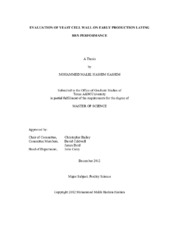| dc.description.abstract | he influence of two levels of yeast cell wall on phase one laying hen performance was investigated in this study. A total of 75 Lohmann W-36 replacement pullets, 17-weeks-old, were distributed among 75 laying hen cages (1 bird per pen). A total of 3 treatments were sequentially assigned to pens and each treatment had 25 replicates. Feeds were prepared according to the management guide for those birds and a single basal diet was divided into three treatments. First was the control basal diet only with no feed additives. The second was the basal diet supplemented with 250 ppm of yeast cell wall (YCW 250) and the third treatment was the basal diet supplemented with 500 ppm of yeast cell wall (YCW 500). Individual birds per cage served as the experimental unit for this study. Feed and water were offered ad libitum. Data were collected when birds were 21 weeks old and hen day egg production was > 90%.
Treatment YCW 250 resulted in significantly higher egg weight than the control and YCW 500 treatment in the first and second production period and was higher than YCW 500 in the third and fourth production period. Feed consumed per dozen eggs was significantly lower in treatment YCW 500 versus treatment YCW 250, but not significantly lower than the control for the first production period and all treatments were not different from each other for the rest of the study. Average feed consumed per bird per day, and monthly cumulative egg production was not different between treatments. Period feed conversion ratios were lower for the second and fourth period (P = 0.15 and 0.18 respectively). There was no treatment effect on interior egg quality except for yolk color for the YCW 500 treatment in the fourth period which had significantly higher Roche color scores than the YCW 250 treatment. Specific gravity, egg shell thickness, egg shell weight, and percent shell weight were significantly higher in hens fed YCW 500 versus YCW 250. Egg shell breaking force was significantly higher in hens fed YCW 250 versus the control group. Overall, feeding a diet supplemented with yeast cell wall improved laying hen performance and 250 ppm YCW had the most significant influences, particularly with respect to increasing egg weight in early production laying hens. | en |


